今天深圳天气有暴风雨,没有事情干,趁着周末和平常晚上写一篇关于Category知识的梳理!可能针对平常只会知道些category基本结论知道的人有些帮助,写这篇博客会按照下面的目录结合实例以及Category的源码进行一一讲解!!!
一、Category的实现原理
1. 前沿Category讲解-所有知识在这
在Xcode中使用Category,可以在里面添加方法以及遵守相应的协议。下面以实例讲解,首先创建ZXYPerson类,类中有对象方法run方法,创建两个分类ZXYPerson+Test和ZXYPerson+Eat,方法分别为test和eat方法。,结构代码如下:
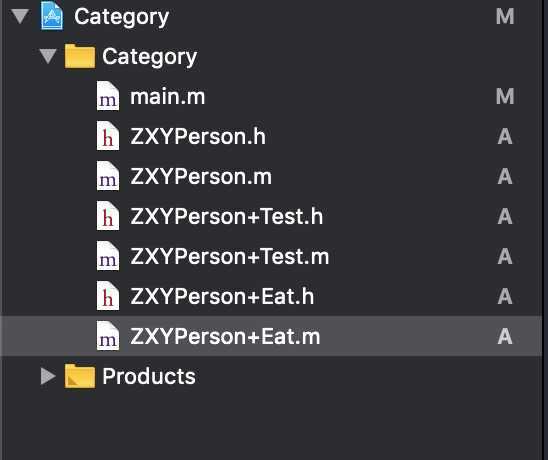
 View Code
View Code运行代码执行结果如下:

上面person是实例对象,所以run实例方法是放在ZXYPerson的实例对象方法中,而对于ZXYPerson(Test)和ZXYPerson(Eat)中的test和eat方法放在哪里了呢?
拓展: isa指针方法
当调用对象方法时,通过instance的isa找到class,最后找到对象方法的实现进行调用
当调用类方法时,通过class的isa找到meta-class,最后找到类方法的实现进行调用

答:Category的方法并不是在编译的时候将方法加入到ZXYPerson的实例对象中的,而是在运行时通过Runtime运行时机制将分类的方法合并到到实例对象中的!
将ZXYPerson+Eat.m clang编译成.cpp文件,查看编译之后的代码(xcrun -sdk iphonesimulator clang -rewrite-objc ZXYPerson+Eat.m)
查看一下协议Category的结构体如下:
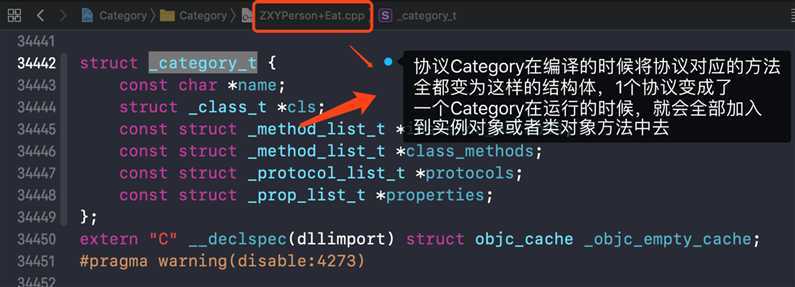
上面协议ZXYPerson+Test以及ZXYPerson+Eat经过编译会编译成两个_category_t结构体,在运行时会把它加入到ZXYPerson的实例对象中(也有可能是类对象中,或者元类对象)


如果换成ZXYPerson+Test协议变为.cpp文件,_category_t这个结构体不会发生改变,但是后面的传参会发生改变如下:

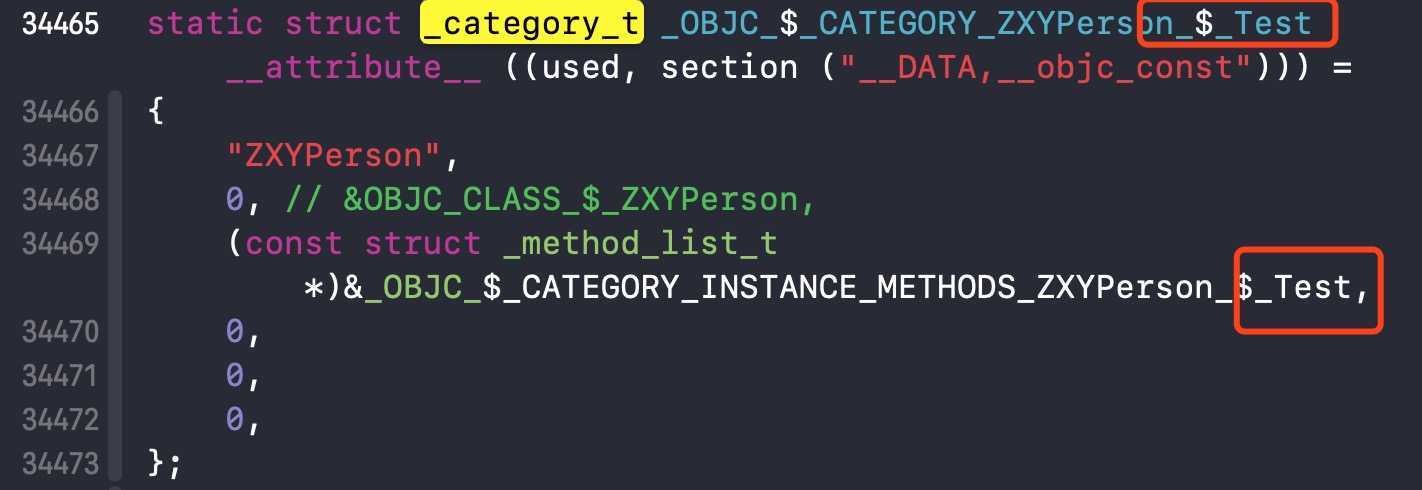
2. 源码讲解
下面来验证一下为什么Category的优先级高于主类?原理是什么?
2.1 结论
 View Code
View Code上面的run方法到底会调用哪一个呢,这个编译顺序有关,最后参与编译的分类会优先调用
抽出上面的main.m代码,ZXYPerson、ZXYPerson+Eat以及ZXYPerson+Test都具有run方法(看上面收起来的代码)
#import <Foundation/Foundation.h>
#import "ZXYPerson.h"
#import "ZXYPerson+Eat.h"
#import "ZXYPerson+Test.h"
int main(int argc, const char * argv[]) {
@autoreleasepool {
ZXYPerson *person = [[ZXYPerson alloc]init];
[person run];
}
return 0;
}
看下编译顺序和运行结果

如果将编译顺序改变下

2.2 原因
查看的OC的源码是objc4-723版本 查看Category的加载处理过程,过程可以为以下步骤:
2. objc-runtime-new.mm
直接看Category加载逻辑,搜索attachCategories,找到对应的实现

下面针对attachCategories的实现开始讲解,大家认认真真看下代码
static void attachCategories(Class cls, category_list *cats, bool flush_caches) { // cls: [ZXYPerson class] // cats - category: 代表[ZXYPerson+Eat,ZXYPerson+Test] if (!cats) return; if (PrintReplacedMethods) printReplacements(cls, cats); bool isMeta = cls->isMetaClass(); /**方法列表 **mlists 二维数组 *[ * [method_t,method_t], * [method_t,method_t] * ] */ method_list_t **mlists = (method_list_t **) malloc(cats->count * sizeof(*mlists)); /**属性列表 **proplists 二维数组 *[ * [property_t,property_t], * [property_t,property_t] * ] */ property_list_t **proplists = (property_list_t **) malloc(cats->count * sizeof(*proplists)); /**协议列表 **protolists 二维数组 *[ * [protol_t,protol_t], * [protol_t,protol_t] * ] */ protocol_list_t **protolists = (protocol_list_t **) malloc(cats->count * sizeof(*protolists)); // Count backwards through cats to get newest categories first int mcount = 0; int propcount = 0; int protocount = 0; int i = cats->count; bool fromBundle = NO; while (i--) {//最后面编译的分类会优先调用,i--,首先取最后一个分类 auto& entry = cats->list[i]; //将category里面的方法列表组都加入到一个数组中 method_list_t *mlist = entry.cat->methodsForMeta(isMeta); if (mlist) { mlists[mcount++] = mlist; fromBundle |= entry.hi->isBundle(); } //将category里面的属性列表组都加入到一个数组中 property_list_t *proplist = entry.cat->propertiesForMeta(isMeta, entry.hi); if (proplist) { proplists[propcount++] = proplist; } //将category里面的协议列表组都加入到一个数组中 protocol_list_t *protolist = entry.cat->protocols; if (protolist) { protolists[protocount++] = protolist; } } //得到类里面的数据 auto rw = cls->data(); prepareMethodLists(cls, mlists, mcount, NO, fromBundle); // 将所有分类的对象方法,附加到类(对象)对象的方法列表中 rw->methods.attachLists(mlists, mcount); free(mlists); if (flush_caches && mcount > 0) flushCaches(cls); // 将所有分类的属性,附加到类(对象)对象的属性列表中 rw->properties.attachLists(proplists, propcount); free(proplists); //将所有分类的协议,附加到类(对象)对象的协议列表中 rw->protocols.attachLists(protolists, protocount); free(protolists); }
对于方法attachCategories的参数cls:在本次例子中代表的是[ZXYPerson class]; cats代表的是分类列表[ZXYPerson+Eat,ZXYPerson+Test]
然后紧接着分配了三个数组空间,三个二维数组mlists,proplists以及protolists分别放着方法、属性和协议列表,然后看一个附加加载过程的原理attachLists()方法
/**方法列表 **mlists 二维数组 *[ * [method_t,method_t],协议ZXYPerson+Test的方法test * [method_t,method_t] 协议ZXYPerson+Eat的方法Eat * ] * addedCount = 2 */ void attachLists(List* const * addedLists, uint32_t addedCount) { if (addedCount == 0) return; if (hasArray()) { // many lists -> many lists uint32_t oldCount = array()->count; //因为ZXYPerson有一个方法run,所以oldCount为1 ,addCount两个分类共有两个方法,所以newCount = 3 uint32_t newCount = oldCount + addedCount; //通过realloc方法重新分配内存,并分配newCount的空间大小 setArray((array_t *)realloc(array(), array_t::byteSize(newCount))); array()->count = newCount; //array()->lists:返回原来的方法列表 //void *memmove(void *__dst, const void *__src, size_t __len);将src的array()->lists移到array()->lists + addedCount,因为addedCount = 2,相当于将array()->lists向后移动2位 memmove(array()->lists + addedCount, array()->lists, oldCount * sizeof(array()->lists[0])); //addedLists:所有分类的方法列表 //void *memcpy(void *__dst, const void *__src, size_t __n); 将src的addedLists拷贝到dst的array()->lists(原来方法的列表) //相当于分类的方法列表拷贝到了原来的方法列表位置,而原来的方法列表位于前面 memcpy(array()->lists, addedLists, addedCount * sizeof(array()->lists[0])); } else if (!list && addedCount == 1) { // 0 lists -> 1 list list = addedLists[0]; } else { // 1 list -> many lists List* oldList = list; uint32_t oldCount = oldList ? 1 : 0; uint32_t newCount = oldCount + addedCount; setArray((array_t *)malloc(array_t::byteSize(newCount))); array()->count = newCount; if (oldList) array()->lists[addedCount] = oldList; memcpy(array()->lists, addedLists, addedCount * sizeof(array()->lists[0])); } }
上面源码对应方法内容也做了比较详细的解释,大家可以细细体会看下!下面memcpy(拷贝)和memmove(移动)函数

现在就来回答第一个问题:Category的实现原理?
1. 通过Runtime加载某个类的所有Category数据
2. 把所有Category的方法、属性、协议数据,合并到一个大数组中,后面参与编译的Category数据,会放在数组的签名
3. 将合并后的分类数据(方法、属性、协议)插入到类原来数据的前面
写到上面了,大家可能有人有疑问,那Category和Objective-C 的class Extension有什么关系区别嘛?
二、Category中有load方法嘛?load方法什么时候调用?
创建ZXYPerson以及ZXYPerson的分类ZXYPerson+Test和ZXYPerson+Eat,在代码中加入load代码,下面是源代码

#import <Foundation/Foundation.h> int main(int argc, const char * argv[]) { @autoreleasepool { } return 0; } #import <Foundation/Foundation.h> NS_ASSUME_NONNULL_BEGIN @interface ZXYPerson : NSObject @end NS_ASSUME_NONNULL_END #import "ZXYPerson.h" @implementation ZXYPerson +(void)load { NSLog(@"ZXYPerson的load方法"); } @end #import <Foundation/Foundation.h> #import "ZXYPerson.h" NS_ASSUME_NONNULL_BEGIN @interface ZXYPerson (Test) @end #import "ZXYPerson+Test.h" #import <Foundation/Foundation.h> @implementation ZXYPerson (Test) +(void)load { NSLog(@"ZXYPerson (Test)的load方法"); } @end #import <Foundation/Foundation.h> #import "ZXYPerson.h" NS_ASSUME_NONNULL_BEGIN @interface ZXYPerson (Eat) @end NS_ASSUME_NONNULL_END #import "ZXYPerson+Eat.h" @implementation ZXYPerson (Eat) +(void)load { NSLog(@"ZXYPerson (Test)的load方法"); } @end

刚刚代码的编译顺序如下:
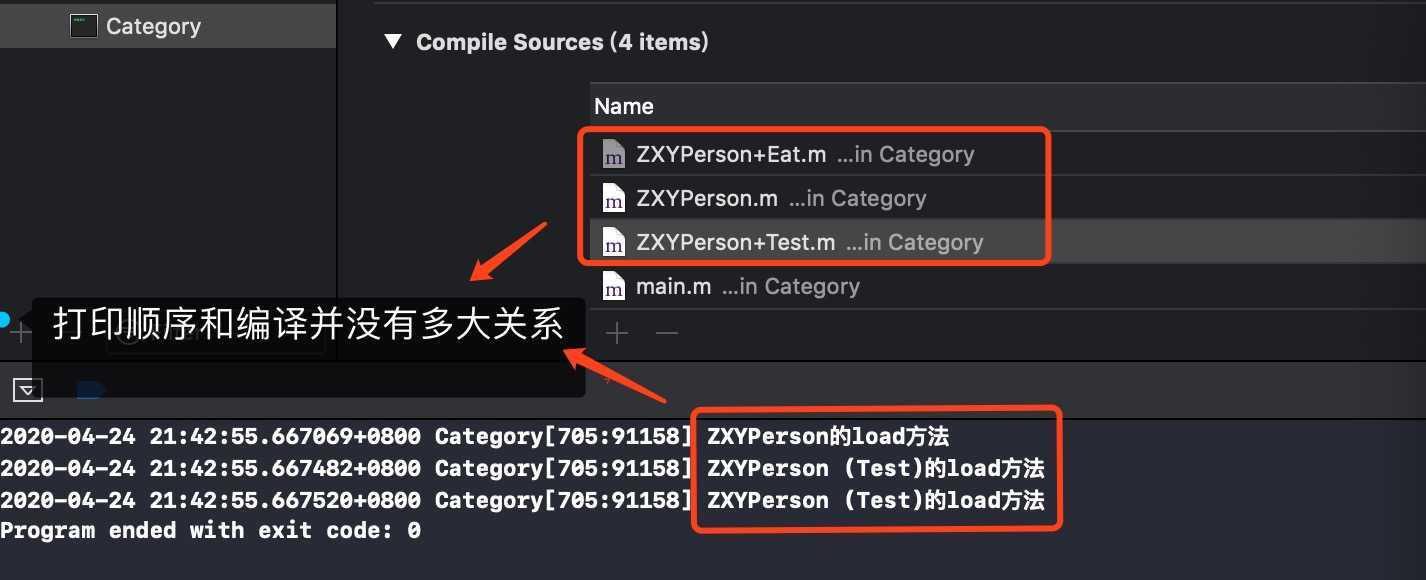
下面通过源码分析一下load的调用顺序! objc4源码解读过程:objc-os.mm
1. _objc_init,点击load_images

2. 进入load_images,看到prepare_load_methods和call_load_methods,首先看call_load_methods
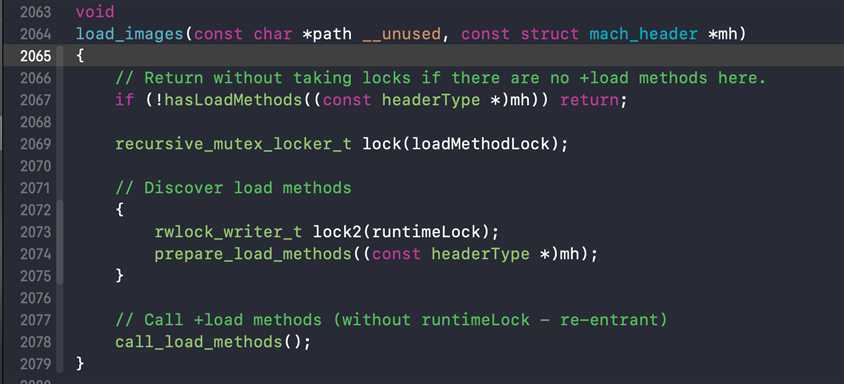
3. 查看call_load_methods
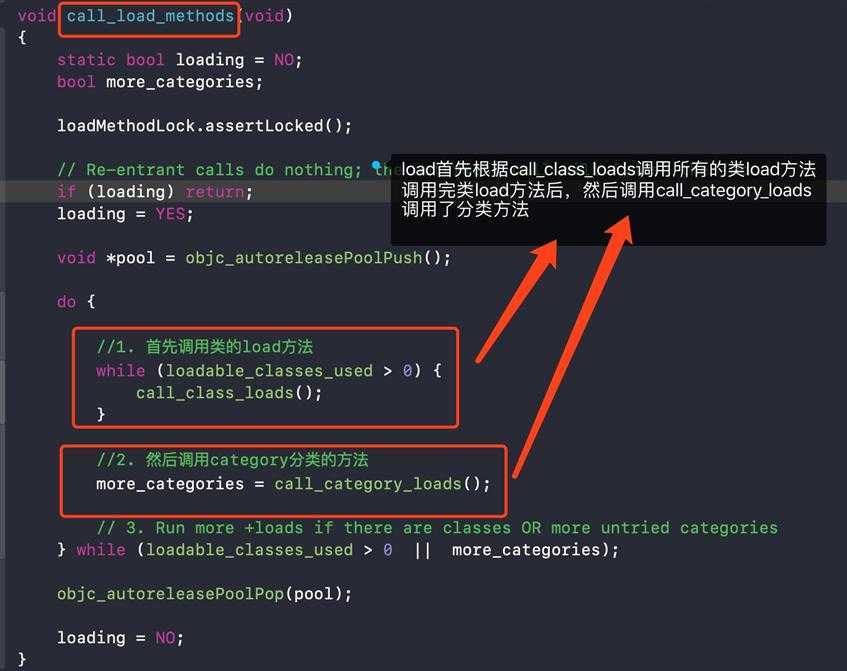
上面就验证了一个观点:先调用类的+load,然后再调用分类的+load
紧接着分别查看call_class_loads方法和call_category_loads方法
4. call_class_loads 加载类的load方法
假如项目中有100个类, 到底先调用哪一个类呢?
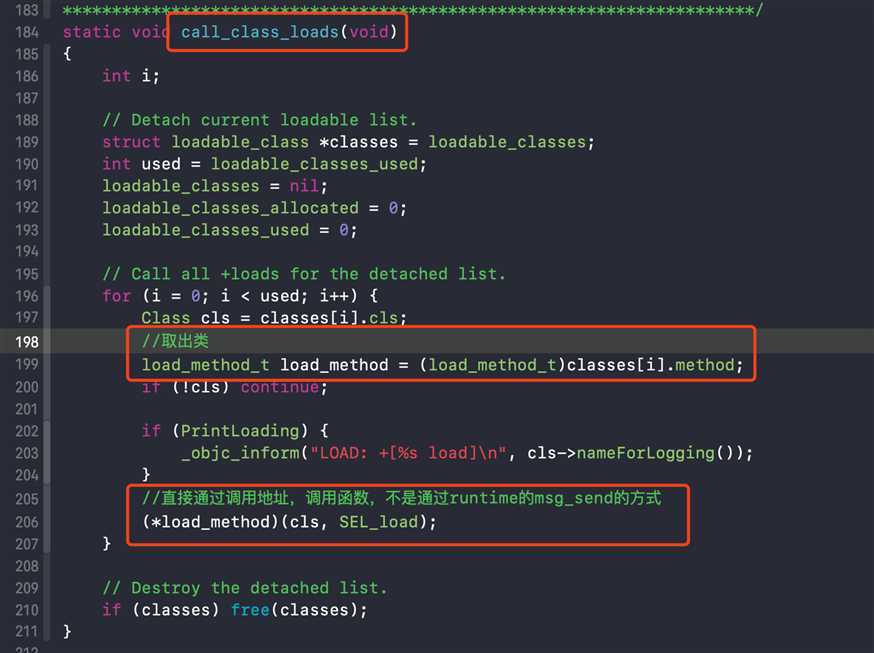
回到上面2中的load_images中,发现调用call_classes_loads之前也做了调用prepare_load_methods,再次进入了prepare_load_method中,看看有没有做一些准备工作:
5. prepare_load_method的实现

prepare_load_method 实现分为以下步骤:
6. 类load的调用顺序
确定类load的调用顺序,依赖于schedule_class_load,它的实现如下:
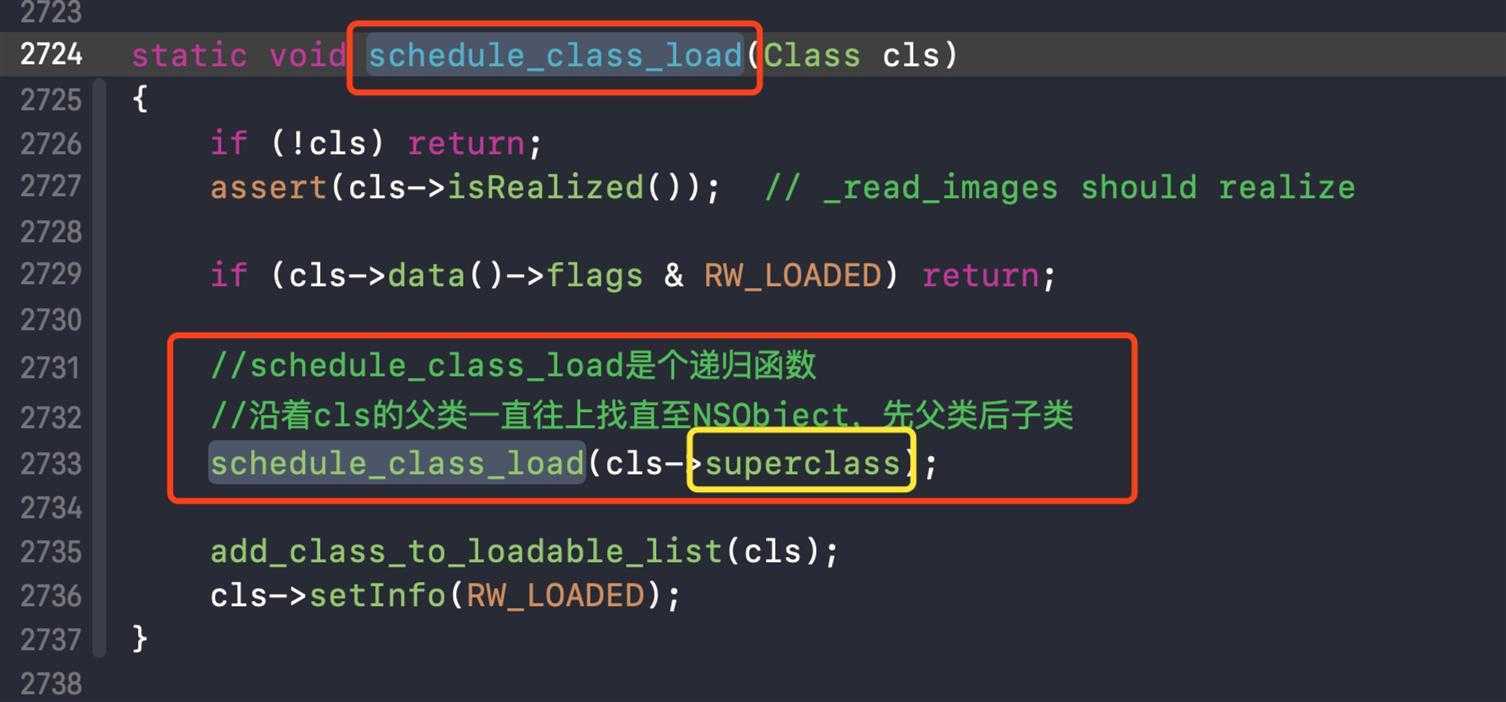
上面源码表明首先调用父类,然后子类!
对于重写了+load的类,load方法调用顺序是先编译的类的父类>先编译的类>后编译类的父类>后编译的类
总结:load调用顺序(+load)方法是根据方法地址直接调用,并不是经过objc_msgSend函数调用
1. 先调用类的+load
2. 再调用分类的+load方法
三、initialize讲解
+initialize的方法在类第一次接受消息时会被调用
1. 例子
首先给ZXYStudent类和Person类覆盖+initialize,主要代码如下
//ZXYPerson + (void)initialize{ NSLog(@"Person + initialize"); } //ZXYPerson +Test + (void)initialize{ NSLog(@"Person (Test1) + initialize"); } //ZXYPerson+Eat + (void)initialize{ NSLog(@"Person (Eat) + initialize"); } //ZXYStudent + (void)initialize{ NSLog(@"Student + initialize"); } //ZXYStudent (Test) + (void)initialize{ NSLog(@"Student (Test) + initialize"); } //ZXYStudent (Eat) + (void)initialize{ NSLog(@"Student (Eat) + initialize"); }
此时运行程序,并没有发现打印,说明运行没有调用initialize
假如给ZXYPerson类发送消息,如下,打印出ZXYPerson+Test的initialize方法
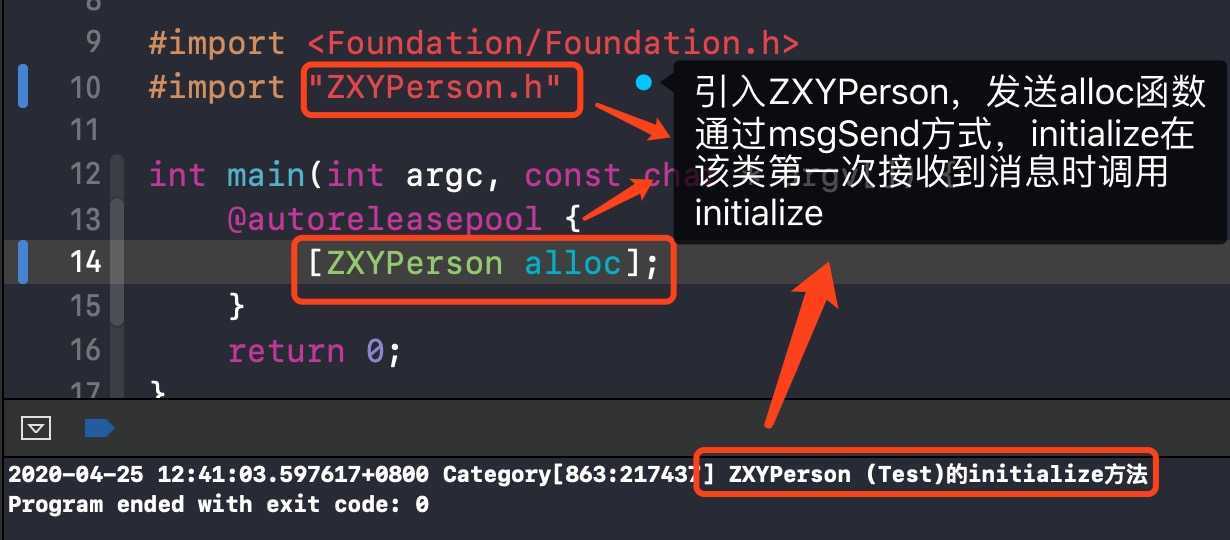
因为initialize是走runtime那套,通过msgSend()方式,所以先打印出ZXYPerson的分类方法,至于先打印出哪一个分类的initialize,看编译顺序(先编译后执行)
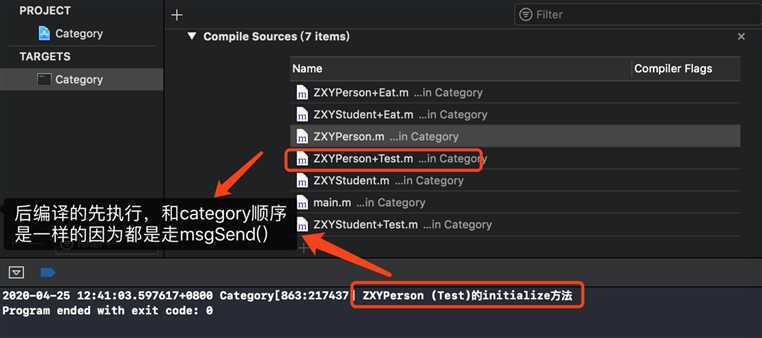
当使用ZXYPerson的子类ZXYStudent发送消息
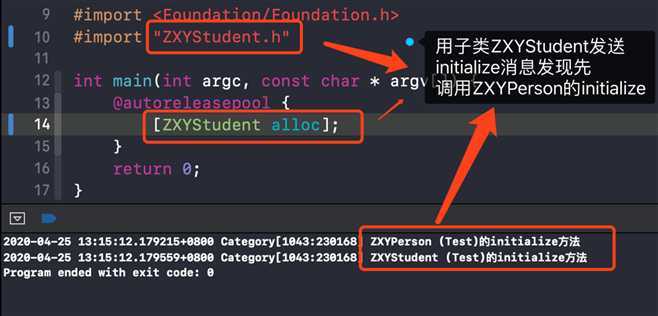
发现先调用ZXYPerson的分类,然后再调用子类的分类!也可以多写几行[ZXYStudent alloc],发现还是一样的打印,说明initialize仅仅在该类第一次收到消息才会调用,下面通过查看源码讲解其调用顺序!
2. 源码讲解
使用objc4查看initialize的源码解读过程主要在 objc-runtime-new.mm中
1). 上面[ZXYStudent alloc]相当于objc_msgSend([ZXYStudent class], @selector(alloc))

2). 然后进行点击红色内容
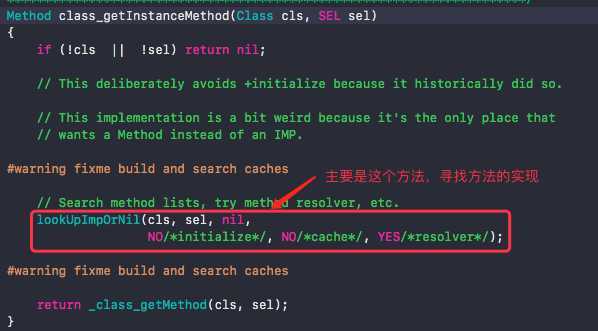
3). 点进去,然后继续寻找lookUpImpOrForward,源码主要内容

这样的源代码说明了每个类的+initialize方法只会调用一次
4). _class_initialize源代码如下
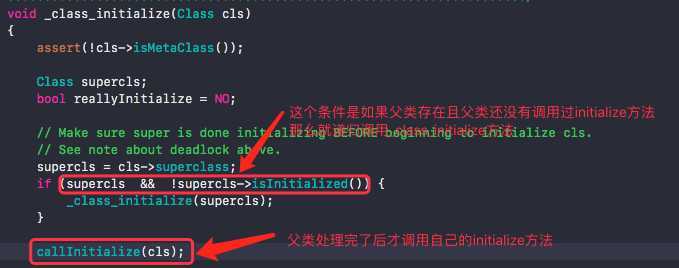
上面的源代码说明首先调用父类的+initialize,然后再调用子类的+initialize,就像上面先调用ZXYPerson的+initialize,然后再调用ZXYStudent的+initialize
5). 最后查看callInitialize

说明+initialize方法是通过msgSend()的方式进行调用
3. 总结
initialize调用顺序
首先调用父类的+initialize方法,然后再调用子类的+initialize
(先初始化父类,然后初始化子类,每个类只会被初始化1次)
通过上面总结下+initialize和+load区别
1. 调用方式
2. 调用时刻
3. 调用顺序
load方法
initialize
四. category能添加成员变量(实例变量)(属性)嘛?
默认情况下: 不能
因为类的内存布局在编译时候就已经确定了,Category是在运行时才加载的,无法更改早已确定的内存布局。
由于分类底层结构的限制,不能添加成员变量到分类中,但是可以通过关联(Associate)方式进行间接实现!
上面就是Category、load和initialize的讲解,希望对大家有所帮助!!!如果觉得写得还不错,给个赞吧!!!
原文:https://www.cnblogs.com/guohai-stronger/p/12763944.html